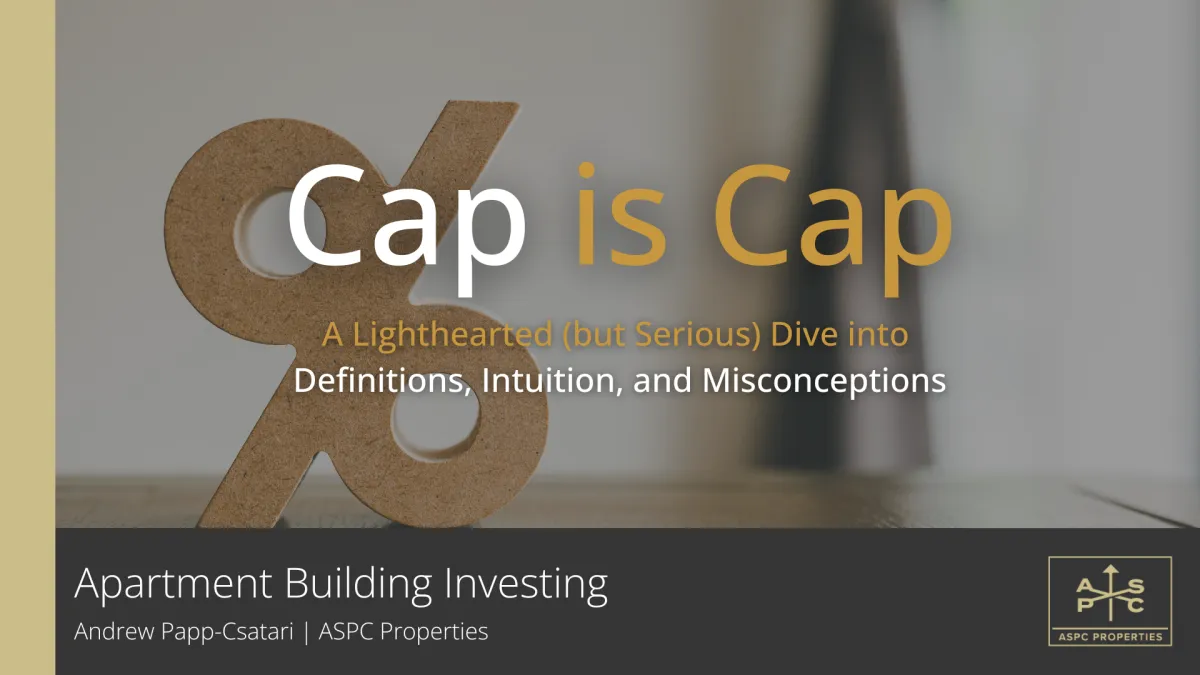ARTICLES, NEWSLETTERS AND MORE
Resources for Real Estate Investors

Cap is Cap: A Lighthearted (but Serious) Dive into Definitions, Intuition, and Misconceptions
The goal of this post is manyfold. Beyond giving you the nuts and bolts of capitalization rates (cap rates) in commercial real estate (CRE)—without burying you in math—I want to highlight the intuitive aspects of this fundamental valuation metric.
But first, let’s talk about the title: ‘Cap is Cap!’
I first heard this phrase at the 2024 Multifamily Conference in Toronto, where a main-stage speaker dropped it like a mic. Was it a catchy way to grab attention? Absolutely. Did it carry a deeper warning? Also, yes.
The first ‘cap’ refers to the well-known capitalization rate in commercial real estate. The second ‘cap’ is slang for ‘lie.’ Her exaggerated claim—“Cap Rate is a Lie!”—was meant to caution against blindly following this single metric without context. And honestly? She had a point.
So, let’s unpack the truth about cap rates.
Definition: What Exactly is a Cap Rate?
A capitalization rate is a valuation and profitability measure in CRE. It’s deceptively simple:
Cap Rate = Net Operating Income (NOI) / Current Market Value

Where:
NOI = Gross Income – Operating Expenses
Operating expenses include property taxes, utilities, management fees, and maintenance, etc.
Debt service (mortgage payments) and tax write-offs do not factor into NOI, because they don’t impact the property’s cash flow generation directly.
This formula gives investors a quick way to gauge a property’s investment potential—but only if used correctly.
Value vs. Price: A Common Pitfall

Some investors use purchase price instead of market value in cap rate calculations. That’s a risky move. Why?
Purchase prices can be distorted (e.g., uninformed buyers, off-market deals, distressed sales).
Older properties bought at historically low prices will show misleadingly high cap rates.
Moral of the story: Stick to market value for an accurate reflection of investment potential.
Cap Rate ≠ ROI (and Why That Matters)
If you Google ‘capitalization rate,’ you’ll find definitions calling it a ‘profitability metric’ or ‘return on investment’ measure. That’s sort of true—but also misleading.
A cap rate shows current return based on existing income, but it does not factor in:
Future appreciation
Debt structure (leverage)
Long-term growth projections
So, while cap rates are a handy shorthand, they are not a full ROI calculation. That requires deeper analysis.
Factors That Influence Cap Rates

1. Opportunity Cost of Capital
CRE competes with stocks, bonds, and other investments. When alternative investment returns rise, demand for real estate drops, pushing prices down and cap rates up (and vice versa).
2. Growth Rate Assumptions
Rents drive income in CRE. If market rents are expected to grow, investors may accept lower cap rates (paying more for today’s income stream). If rents stagnate, expect higher cap rates (less willingness to pay premium prices).
3. Risk (Perceived and Real)
Investors accept lower returns for stable, low-risk properties (low cap rates) and demand higher returns for riskier ones (high cap rates). Location, tenant quality, and economic conditions all factor in.
Other macro/microeconomic influences? Absolutely. Things like GDP trends, migration patterns, and financing conditions all play a role.
Cap Rate as a Quick and Dirty Comparison Tool
Cap rates provide a fast way to compare deals, but remember:
Higher cap rates can signal better deals—but also higher risk.
Lower cap rates can mean stability—but also lower returns.
Comparing two similar properties? Higher cap rate = better deal (if risk factors match).
So, when you see a real estate ad hyping a “can’t-miss, once-in-a-lifetime cap rate”, take a step back. A high cap rate might just reflect a risky market.
Cap Rates in Action: Different Perspectives

1. Rate of Return for Cash Buyers
Since NOI excludes debt payments, cap rates represent the unleveraged return on an all-cash purchase.
2. Reverse Engineering Property Value
By flipping the cap rate formula, investors can estimate fair market value:
Property Value = NOI / Cap Rate
3. The NOI Multiple (Time Horizon Calculation)
Think of the cap rate as an inverse time horizon measure:
Years To Recover Investment = 100 / Cap Rate
Example: A 5% cap rate means it would take 20 years for NOI to equal the purchase price.
Timing Matters: Entry vs. Exit Cap Rates
Entry Cap Rate (Going-In Cap Rate): Based on in-place rents at purchase.
Exit Cap Rate (Terminal Cap Rate): Based on projected income at sale or refinance.
Astute investors always stress-test exit cap rates—assuming higher cap rates at resale to hedge against market downturns.
Cap Rate Trends: What Do They Tell Us?
Cap rate compression: Prices rising, bidding wars, hot market.
Cap rate expansion: Rising risk, falling demand, cautious investors.
Tracking historical cap rates helps investors navigate market cycles and make informed decisions.
Limitations & Red Flags

1. Cap Rate Alone Isn’t Enough
Smart investors use multiple metrics—Internal Rate of Return (IRR), Equity Multiple, and Discounted Cash Flow (DCF)—for a holistic investment picture.
2. Time Value of Money Ignored
A cap rate doesn’t account for future cash flow fluctuations, financing structures, or inflation-adjusted returns.
3. Garbage In, Garbage Out
Bad data = bad cap rate calculations. Ensure NOI figures include all relevant expenses (maintenance, property management, etc.).
A Quick Detour: The Gordon Model
If NOI is expected to grow at a constant rate, you can estimate cap rate using:
Cap Rate = Required Rate of Return – Growth Rate
Example: If an investor demands a 10% return and NOI is growing at 1% annually, the cap rate should be 9%.
Cap Rates & Interest Rates: A Complex Relationship

While people assume rising interest rates = rising cap rates (and falling property values), real-world data suggests a more nuanced relationship.
We’ll dive deeper into this in a future post!
Final Thoughts: Cap or No Cap?
Cap rates are a powerful tool—but they’re not the whole story. They provide a snapshot, not a full picture.
So next time you hear “Cap is Cap”, remember: It’s not a lie—it’s just incomplete. And as always, the pros are there to navigate the nuances, so you don’t have to.
Sign up for our mailing list for exclusive updates.
Enroll to receive our newsletter with exclusive opportunities and updates.
We will not, in any circumstances, share your personal information with other individuals, public organizations, or corporations. We do not sell, communicate, or disclose your information to any mailing lists. By providing your information, you are consenting to receive occasional communication, such as newsletters, from ASPC.

© 2025 ASPC Properties. All Rights Reserved
Disclaimer: The information provided on this website is for general informational purposes only and should not be considered as financial, legal, or investment advice. ASPC Properties does not make any representations or warranties, express or implied, regarding the accuracy, completeness, or suitability of the information on this site. Real estate investments inherently involve risks, and past performance is not indicative of future results. Investors should conduct their own due diligence and seek professional advice before making any investment decisions. ASPC Properties is not liable for any loss or damage arising from reliance on the information provided on this website.
We will not, in any circumstances, share your personal information with other individuals, public organizations, or corporations. We do not sell, communicate, or disclose your information to any mailing lists. By providing your information, you are consenting to receive occasional communication, such as newsletters, from ASPC.

